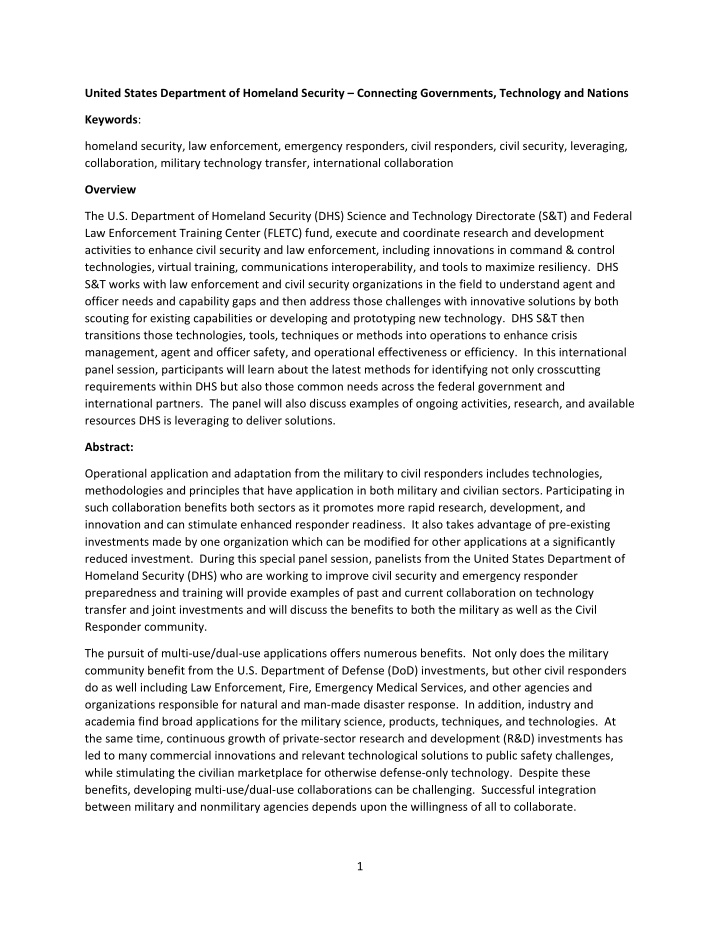



United States Department of Homeland Security – Connecting Governments, Technology and Nations Keywords : homeland security, law enforcement, emergency responders, civil responders, civil security, leveraging, collaboration, military technology transfer, international collaboration Overview The U.S. Department of Homeland Security (DHS) Science and Technology Directorate (S&T) and Federal Law Enforcement Training Center (FLETC) fund, execute and coordinate research and development activities to enhance civil security and law enforcement, including innovations in command & control technologies, virtual training, communications interoperability, and tools to maximize resiliency. DHS S&T works with law enforcement and civil security organizations in the field to understand agent and officer needs and capability gaps and then address those challenges with innovative solutions by both scouting for existing capabilities or developing and prototyping new technology. DHS S&T then transitions those technologies, tools, techniques or methods into operations to enhance crisis management, agent and officer safety, and operational effectiveness or efficiency. In this international panel session, participants will learn about the latest methods for identifying not only crosscutting requirements within DHS but also those common needs across the federal government and international partners. The panel will also discuss examples of ongoing activities, research, and available resources DHS is leveraging to deliver solutions. Abstract: Operational application and adaptation from the military to civil responders includes technologies, methodologies and principles that have application in both military and civilian sectors. Participating in such collaboration benefits both sectors as it promotes more rapid research, development, and innovation and can stimulate enhanced responder readiness. It also takes advantage of pre‐existing investments made by one organization which can be modified for other applications at a significantly reduced investment. During this special panel session, panelists from the United States Department of Homeland Security (DHS) who are working to improve civil security and emergency responder preparedness and training will provide examples of past and current collaboration on technology transfer and joint investments and will discuss the benefits to both the military as well as the Civil Responder community. The pursuit of multi‐use/dual‐use applications offers numerous benefits. Not only does the military community benefit from the U.S. Department of Defense (DoD) investments, but other civil responders do as well including Law Enforcement, Fire, Emergency Medical Services, and other agencies and organizations responsible for natural and man‐made disaster response. In addition, industry and academia find broad applications for the military science, products, techniques, and technologies. At the same time, continuous growth of private‐sector research and development (R&D) investments has led to many commercial innovations and relevant technological solutions to public safety challenges, while stimulating the civilian marketplace for otherwise defense‐only technology. Despite these benefits, developing multi‐use/dual‐use collaborations can be challenging. Successful integration between military and nonmilitary agencies depends upon the willingness of all to collaborate. 1
DHS works with civil security practitioners in the field to understand their challenges and develop innovative technologies to improve crisis management, as well as the safety, effectiveness, and efficiency of responders themselves. In this panel session, DHS will provide an overview of efforts to use artificial intelligence to deliver advanced situational awareness. This new technology will sift through the vast amounts of available data, such as infrastructure status, demographic reports, and public social media postings, and intelligently use only the most appropriate information and optimally deliver the relevant and actionable knowledge to the end user. The proposed panel will include DHS subject matter experts including representatives from the Science and Technology Directorate, Federal Law Enforcement Training Centers, and the DHS Sweden liaison. Each of these panelists share the common mission of ensuring the safety and security of the people they serve. DHS works with its international partners to aggregate common technical capability gaps for industry to consider when developing responder technology and to educate emergency responders about available technologies. Benefits: This session will provide insight on developing effective partnerships between the civil responder community, military, industry and academia. Examples will be provided of the tools, technologies and training methodologies that the U.S. Department of Homeland Security (DHS) is researching and developing to enhance civil security and law enforcement such as command & control technologies, virtual training, communications interoperability, and tools for resiliency. Participants will learn about the latest research results, resources, and technology solutions available to address mission gaps identified by the emergency responder community. Panelists: Michael Robbs Supervisory Law Enforcement Instructor/Technology Liaison U.S. Department of Homeland Security ‐ Federal Law Enforcement Training Centers Michael Robbs is the Federal Law Enforcement Training Centers (FLETC) Technology Liaison in Orlando, Florida. He collaborates directly with the Department of Defense’s simulation community, industry and academia to identify, investigate and leverage technologies having application in law enforcement training to meet the FLETC’s ever changing and growing training requirements. Syed Mohammad, Ph.D. Director, Modeling and Simulation Technology Center U.S. Department of Homeland Security – Science and Technology Directorate Dr. Syed Mohammad joined the Department of Homeland Security (DHS) Science and Technology Directorate (S&T) in 2014 and serves as the Director for the Modeling and Simulation Technology 2
Center. Prior to DHS, Syed served DoD for 13 years in various R&D, engineering, and acquisition positions with the US Army’s Tank‐automotive Command. Stephanie Okimoto Deputy Director, International Cooperative Programs Office (ICPO) U.S. Department of Homeland Security – Science and Technology Directorate Stephanie Okimoto serves as the Deputy Director in the U.S. Department of Homeland Security (DHS) Science and Technology Directorate (S&T) International Cooperative Programs Office (ICPO). She develops partnerships with international governments to strengthen knowledge of threats to provide innovative research and development opportunities and promotes international collaboration. Saravana Kumarasamy, Ph.D. Senior Assistant Director, Human Factors and Simulation Center of Excellence Singapore Ministry of Home Affairs, Home Team Science & Technology Agency Dr. Kumarasamy serves as the Senior Assistant Director for Human Factors and Simulation Center of Excellence within the Home Team Academy, Home Team Science and Technology Agency (HTX), Singapore. 3
Recommend
More recommend